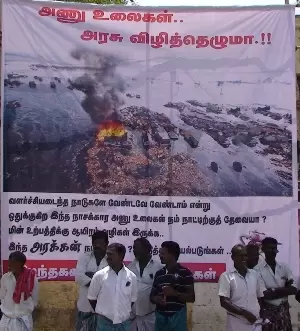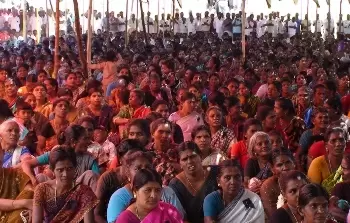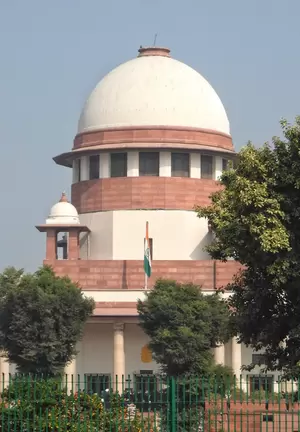Time to scrap Koodankulam and start focusing on renewable energy

19-October-2011
Vol 2 | Issue 41
It was uncharacteristic of Prime Minister Manmohan Singh, known to sit on pressing issues in the hope the problems would vanish, to tell an anti-nuclear delegation from Tamil Nadu on their face that he will not order stoppage of work at the Koodankulam Nuclear Project being set up by Russia, pending convincing the agitating people of the area about the safety of the VVER-1000 MWe reactors.
Seeking Tamil Nadu Chief Minister Jayalalithaa’s co-operation for completing the project, he said sudden stoppage of work could impede the State’s development and industrialisation.
 |
|
Posters and banners describing the harmful effects of nuclear radiation have appeared all over Koodankulam
|
In a letter to Jayalalithaa, he assured that the atomic power project will not threaten the safety or the livelihood of the people of Koodankulam and promised to depute a committee of experts to dispel the people’s fears.
Ever since Rajiv Gandhi and the then USSR President, Mikhail Gorbachev, signed an Inter-Governmental Agreement on 20 November, 1988, to construct two VVER-1000 MWe units at Koodankulam in Thirunelveli district of Tamil Nadu, the people of the area under the banner of People’s Movement Against Nuclear Energy have been agitating against the project.
They have heard enough homilies on the safety and advantages of nuclear power from sarkari scientists but were unconvinced. A rustic team from Koodankulam was even taken to the Kalpakkam power plant near Chennai to show them how safe and beautiful the project was and how happily people were living in its vicinity.
What these simple people have been asking and the government has not been able to give a convincing answer is: “Isn’t there a simpler and safer way of boiling water to produce steam to turn turbines that generate electricity?”
The Russian-aided nuclear power plant was actually meant for Kerala. The erstwhile Soviet Union had a special relationship with Kerala, the first Indian State to elect a Communist government.
It even had a cultural centre in Thiruvananthapuram without having a consulate there. Kerala, blessed with a number of swift flowing rivers, was entirely dependent on hydroelectric power.
As demand for electricity grew, it planned a mega hydroelectric project in the ecologically sensitive Silent Valley. The Union government withheld environmental clearance.
It was then the USSR government came forward to set up a 2000-MWe nuclear power plant in the State with the option of raising its capacity to 8000 MWe in stages.
The main attraction of the offer was a “binding commitment” to supply enriched uranium fuel for the lifetime of the reactors at a time the Nuclear Supplier Group was barred from selling enriched uranium to India.
The USA tried to scuttle the aagreement. Gorbachev stood firm. A place near Kothamangalam in Kochi was selected to set up India’s largest civil nuclear power plant.
The enlightened people of Kothamangalam rose in revolt and the site was abandoned. The Kerala government then chose the remote Kasaragod district in the north. The response of the people there was hostile to the idea of a nuclear power plant in their midst.
New Delhi, faced with increasing nuclear isolation after the first Pokran blast, did not want to forgo the Soviet offer and zeroed in on Koodankumam, a fishing hamlet in south Tamil Nadu, on the assumption the soft-spoken Tamil people could be ‘managed.’
Only a few years earlier Indira Gandhi had gifted a part of Ramanathapuram district, Kachchatheevu, to Sri Lanka to help out her counterpart in the island republic, Srimavo Bandaranaike, tide over a difficult phase in her political career, without any serious protest from the State government.
If locating a nuclear power plant is not good for Kerala, how could it be good for Tamil Nadu? New Delhi should shed this idea of taking Tamil Nadu for granted.
However safe the Koodankulam project might be, nuclear power involves radiation exposure at all stages of its fuel cycle, from uranium mining and fuel fabrication to reactor operation and maintenance, to spent-fuel handling, storage and re-processing.
Reactors leave a toxic trail of high-level radioactive wastes which remain hazardous for thousands of years.
Nuclear power is exorbitantly expensive if all the hidden costs are taken into account. That is why the private sector has not come forward to set up nuclear power plants.
 |
|
The protest against the nuclear project is growing stronger by the day with more women and children taking to the streets
|
For all the claims of in-built safety measures, India has no independent authority that can evolve safety standards and regulate reactors for safety. The industry acknowledges that nuclear power carries high risks of damage but wants government, that is, the public, to subsidise and absorb them
India’s CANDU type nuclear power reactors release massive quantities of radioactive pollution on a daily basis. Tritium gets into air, rivers and the sea in the form of radioactive water.
It contaminates food and drinking water, and it is easily absorbed into our body. Tritium is a carcinogen and it causes birth defects. It replaces ordinary non-radioactive hydrogen and travels throughout the body, going wherever water goes.
It becomes part of our DNA and that is where it does its damage. Tritium decays within our body, ejecting high velocity beta particles that can break the chemical bonds of our DNA. The result can be cancer or birth defects.
A developing foetus is particularly susceptible to damage from exposure to radiation. There are higher rate of childhood leukemia near nuclear plants due to chronic exposure to radioactive pollution to reactors. The Department of Atomic Energy effectively uses the Press Information Bureau of the government of India to suppress accidents that do happen in our nuclear establishments.
News about “the worst accident in the four decade DAE experience,” according to their own admission, which took place at the Kalpakkam power plant on 21 January a few years ago in which six workers were exposed to an overdose of radiation, took eight months to come out. Secrecy surrounds all our atomic establishments.
Public opinion has turned against nuclear power generation all over the world following the Fukushima Daiichi and Chernobyl disasters. While the full impact of Fukushima is yet to be assessed, considered the worst in the history of nuclear disasters, the radioactive fallout from the 26 April, 1986, explosion in the Chernobyl nuclear reactor in Ukraine was 200 times greater than the nuclear bombs that destroyed Hiroshima and Nagasaki.
The exact number of casualty is a matter of controversy, but according to a UN report, nine million people had been affected and an area of 155,000 sq. km. in Belarus, Ukraine and Russia is still severely contaminated.
Governments from around the world had pledged $785 million to seal the stricken reactor within a 20,000-tonne steel shield, large enough to enclose London’s St. Paul’s Cathedral, designed to prevent any further radiation from escaping for the next 100 years.
The shield is intended to stay in place until the Ukrainian government finds a permanent storage facility for the 200 tonnes of uranium and one tonne of radioactive plutonium still inside the crippled Chernobyl plant.
The widely held belief that global warming can be prevented by switching to nuclear power is not true. In a well documented book “Nuclear Power is Not the Answer to Global Warming or Anything Else,” Dr Helen Caldicott points out that if a detailed accounting of CO2 emissions is made during all the phases of nuclear power generation, including both construction and decommissioning of the plant, together with mining, transportation and refinement of uranium ore, the CO2 emissions are seen to be comparable with those produced by a coal-fired power plant.
“Scientific American” has recently come out with a plan to power 100 per cent of the world with renewable energy. It argues with figures how renewable future is feasible without fossil fuels of any kind or nuclear energy.
It proposes that 51 per cent of energy could be provided through 3.8 million wind turbines of five megawatts capacity each. All these giant windmills together with mandatory intervening spaces would occupy only one per cent of the earth’s surface.
For solar energy, it suggests a mix of 30 per cent from rooftop panels on buildings and 70 per cent contributed by 89,000 photovoltaic and concentrated solar power plants of 300 megawatts each, which would take no more than 0.33 per cent of the earth’s surface.
Balance could be obtained from 900 hydroelectric stations out of which 70 per cent are already in place. Development of geo-thermal and tidal energy could be explored simultaneously.
The plan gives a grand vision of how energy requirements can be met sustainably.
Manmohan Singh need not despair that there is no clean future without exposing future generations to the grave dangers the nuclear energy option poses.
Sam Rajappa is Consulting Editor of The Weekend Leader. The above article first appeared in The Statesman
Also Read
Ten reasons to say ‘No’ to nuclear energy
















